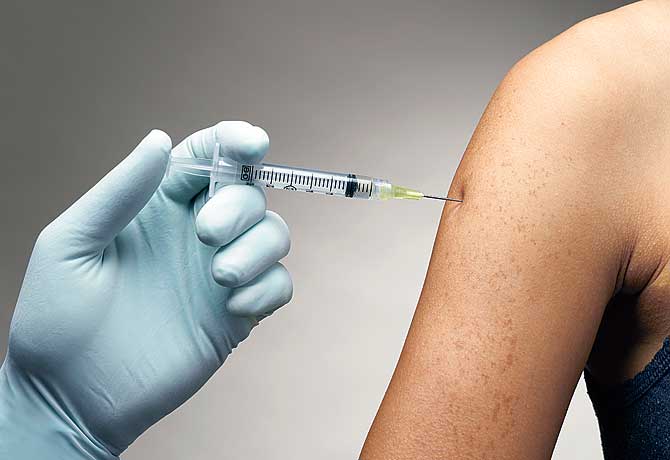
Vaccines enlist the immune system in the battle against cancer. Treatments would begin after surgery and chemo, to prevent relapse.
(2 of 4)
When Is a Vaccine Not a Vaccine?
There may be no better example of what is meant by preventive medicine than the strategy of vaccination. A healthy person is given a tiny taste of a virus — flu or polio, say — that's too weak to cause illness but just enough to introduce the body to the pathogen. If the virus later shows up for real, the immune system is primed and waiting for it.
That's close to how a cancer vaccine works, but not precisely. Most experts see cancer vaccines as a hybrid of treatment and prevention. While it's true that the Food and Drug Administration has approved vaccines against cervical and liver cancer, both are actually designed to fight the viruses most responsible for causing the disease, as opposed to targeting cancer itself — human papillomavirus in the case of cervical cancer and hepatitis B in the case of liver tumors.
Using vaccines to prevent nonviral cancers in someone who is disease-free is a whole different matter. For one thing, it's much more difficult to determine a person's chance of developing a particular type of cancer than it is to determine the likelihood of being exposed to, say, the influenza virus or chicken pox. What passes for "exposure" in the case of nonviral cancers is a combination of genes and environment and a range of other X factors that can vary from person to person. How do you vaccinate against your family legacy of breast cancer or your constant exposure to secondhand cigarette smoke?
But that doesn't mean the immune system can't be exploited in a different way. Cancer vaccines would ideally be used in patients whose disease has already been diagnosed and treated with surgery, chemotherapy or radiation. They would then be immunized as a way to prevent the cancer from coming back and spreading. Such metastases are actually the leading cause of death from cancer. "The charm of working with the immune system is that we can use the body's own defense mechanisms to possibly get to that last cancer cell or at least create a surveillance system that keeps that cancer under control," says Lichtenfeld.
Trial by Failure
Before they can seek out these smaller, hidden deposits of tumors, however, cancer vaccines must prove that they can actually target and shrink a cancer's more conspicuous growths. This, it turns out, is obvious in theory but devilishly challenging to show in reality.
Take melanoma. In 2002 scientists at the John Wayne Cancer Institute in Santa Monica, Calif., thought they had finally figured out a way to turn the immune system against the skin cancer. Instead of trying to activate immune cells with snippets of tumor proteins they had created in the lab, they decided to grind up melanoma tumors and use the malignant slurry to prod the right immune cells into action. The result was Canvaxin, a vaccine against aggressive melanoma that was loaded up with 20 different tumor-specific components of melanoma, teaching the body new ways to recognize the disease. More than 1,500 patients were given the vaccine after being treated with surgery and chemotherapy. In the first five years of follow-up, the shot proved safe and worthy of moving into the most advanced level of human testing. But in April 2005, the scientists and the biotech company they had enlisted to develop the vaccine were forced to stop their studies when it became obvious that the vaccinated patients were not living any longer than the unvaccinated ones. "That put a damper on things," says Schwartzentruber. "They had what they thought was a promising start, and it was an international, multi-institutional study with a large number of patients."
In retrospect, Schwartzentruber says, the problem may have been that the vaccine was forced to work alone. Even the most well-sensitized immune system may be fooled by the homegrown nature of cancer, recognizing malignant cells as just another part of the body — which they are — and thus giving them a pass. When the cancer finally grows big enough to represent a real threat, it's too late.